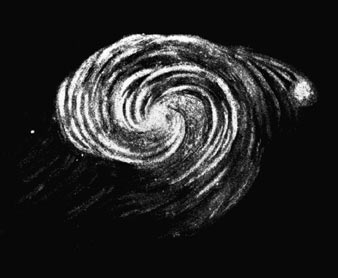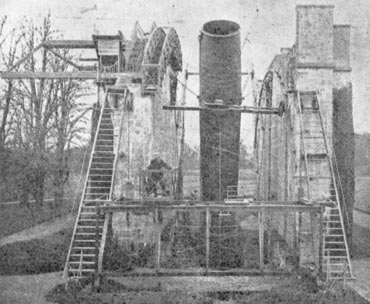M51 was discovered by Charles Messier on October 13, 1773. Messier apparently recognized only the larger portion. It was left to Pierre Méchain on March 21, 1781 to recognize the smaller portion. Messier described it as “very faint nebula, without stars”. Mechain then reported it as “It is double, each has a bright center, which are separated 4’35”. The two “atmospheres” touch each other, the one is even fainter than the other.” Hence M51 is comprised of M51a and M51b, and has two NGC identifications, NGC 5194 and NGC 5195.
It was not until William Parsons, 3rd Earl of Rosse, using the famous 72” speculum reflector The Leviathan of Parsonstown at Birr Castle Ireland , observed and drew the now recognizable spiral structure of M51.

The 72-inch Leviathan telescope, still regarded as the largest amateur telescope in history, replaced a 36-inch telescope that Parsons had built previously. Parsons had to invent many of the techniques he used for constructing the Leviathan, both because its size was without precedent and because earlier telescope builders had guarded their secrets or had simply failed to publish their methods. The Leviathan of Parsonstown was considered the scientific, technical, and architectural achievement of its time, and images of it were circulated widely within the British commonwealth. Building of the Leviathan began in 1842 and it was first used in 1845. It was the world’s largest telescope, in terms of aperture size, until the early 20th century when the building of the 100-inch Hooker telescope at Mt. Wilson ascended to the throne of World’s Largest Telescope. William Parson was the last amateur astronomer to build and own the world’s largest telescope. Since then the title of world’s largest telescope has gone to instruments built and operated by educational or scientific institutions.

The Leviathan was not a perfect telescope. It was awkwardly mounted and was labor intensive to operate and use. It had a limited alt-az mounting (no clock drive here!) capable of only views 7º to either side of the meridian. It used a speculum mirror that tarnished easily. As a result, two speculum mirrors were created, so that one could be used for observations while an army of men on a monthly basis would disassemble the telescope, change out the mirrors, realign the newly installed optics while re-polishing the other mirror.
The poor Irish weather often interfered with the Leviathan’s operational use. But when the weather was good, William Parsons made scientific history with his Leviathan of Parsonstown.
The largest amateur telescope today is a 70-inch Dobsonian, constructed from a U.S. Government surplus spy satellite mirror and parts from Lowe’s and Home Depot, built by Mike Clements and currently housed in the Salt Lake City area of Utah.